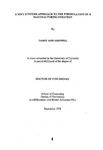A soft systems approach to the formulation of a manufacturing strategy
| dc.contributor.author | Greswell , Tammy Jane | |
| dc.contributor.other | School of Engineering, Computing and Mathematics | en_US |
| dc.date.accessioned | 2011-09-23T10:10:34Z | |
| dc.date.available | 2011-09-23T10:10:34Z | |
| dc.date.issued | 1998 | |
| dc.identifier | Not available | en_US |
| dc.identifier.uri | http://hdl.handle.net/10026.1/619 | |
| dc.description | Merged with duplicate record 10026.1/2767 on 14.02.2017 by CS (TIS) | |
| dc.description.abstract |
This work investigated the understanding and use of current manufacturing strategy methods within the UK aerospace industry. Several key issues were identified which suggested a need to rethink the process of manufacturing strategy formulation. The set of issues included: the lack of explicit manufacturing strategies by several case organisations, a lack of the general use of developed manufacturing strategy tools and techniques, and a general evolution of organisations from functionally based to a business process focus. These issues suggested that the current approaches to manufacturing strategy were not reaching their target audience practitioners, and that further development of the manufacturing strategy formulation process was necessary to improve the usability and subsequent use of manufacturing strategy concepts. Taking these issues into account, the research used three cycles of learning using the soft systems methodology to develop a greater understanding of the domain of manufacturing strategy. Cycle One identified the process of manufacturing strategy formulation as a problem situation and used systems concepts and soft systems methods to develop three manufacturing strategy archetypes. These included a customer focussed / market led approach, a best practice approach and a knowledge-based approach to manufacturing strategy. Each archetype was developed using systems concepts by defining a root definition and developing conceptual models in order to make the thinking explicit, systemic, and useful to practitioners. Cycle Two explored the manufacturing strategy formulation processes of aerospace organisations and provided a sound base to identify appropriate changes to current manufacturing strategy methods based on both functionally orientated and business process focussed organisations. The third cycle developed a modified approach to the formulation of a manufacturing strategy using soft systems concepts, which was incorporated into a workbook format in order to test out the changes identified and learning experienced in the previous cycles. The format and use of the approach were validated using several case organisations, using the criteria that research results should be useful to practitioners within the production and operations management domain. The contribution of the work comes from the critical evaluation of existing manufacturing strategy methods and techniques, the development of three manufacturing strategy making systems and the development of a modified approach for developing a manufacturing strategy. The evaluation determined that the above were not well enough developed for the evolving aerospace industry. Opportunities for improvement were identified which were incorporated into an improved method for formulating a manufacturing strategy. The method makes use of three manufacturing strategy archetypes, developed using systems theory to ensure the thinking surrounding manufacturing strategy is made explicit and systemic. The approach is based around Checklands' (1990) soft systems methodology and each iteration of the methodology should be seen as a cycle of learning. | en_US |
| dc.description.sponsorship | British Aerospace PLC | en_US |
| dc.language.iso | en | en_US |
| dc.publisher | University of Plymouth | en_US |
| dc.title | A soft systems approach to the formulation of a manufacturing strategy | en_US |
| dc.type | Thesis | |
| dc.identifier.doi | http://dx.doi.org/10.24382/3990 | |
| dc.identifier.doi | http://dx.doi.org/10.24382/3990 |
Files in this item
This item appears in the following Collection(s)
-
01 Research Theses Main Collection
Research Theses Main


